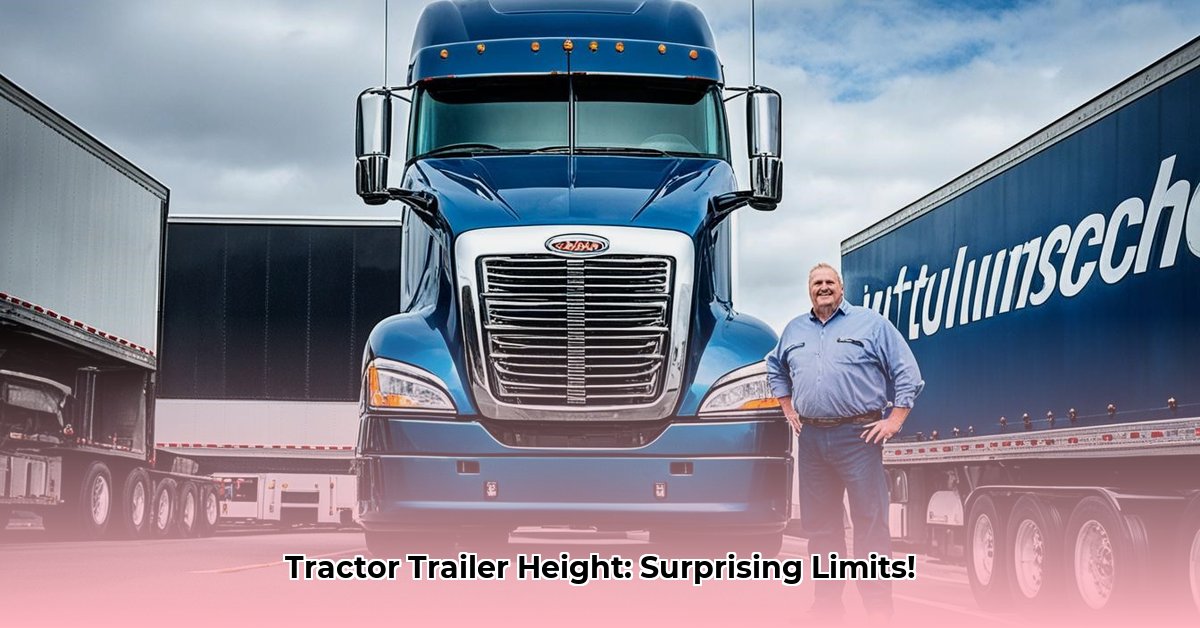
Ever wondered about the height of those massive tractor-trailers? It's more complex than you might think. This guide breaks down the height of semi-trucks in the US, covering everything from average heights to oversized loads, and explaining why knowing these heights is crucial for safety and compliance. Whether you're a driver, shipper, or simply curious, this guide provides essential information. For more on empty trailer weights, see this helpful resource: empty trailer weights.
How Tall is a Tractor Trailer?
The common answer is around 13.5 to 13.6 feet (4.1 to 4.2 meters). However, this is a simplification. Many factors influence a tractor-trailer's actual height.
The Many Heights of Big Rigs
Several factors determine a tractor-trailer's overall height:
Trailer Type: Different trailers have different heights. Flatbeds (used for open cargo) are typically shorter than enclosed dry vans (for boxed goods). Specialized trailers like step-decks and double drops, designed for oversized loads, are even taller.
Cargo: The height of the cargo significantly impacts the overall height. Tall machinery or stacked boxes will increase the total height considerably.
Aftermarket Add-ons: Air conditioners, lights, antennas, and other modifications all add to the overall height, potentially exceeding legal limits.
Understanding these variations is critical for safety and legal compliance.
Staying on the Right Side of the Law: Height Restrictions and Safety
Exceeding height limits can lead to infrastructure damage and accidents. Therefore, adherence to regulations is paramount.
How to Ensure Compliance
Follow these steps to ensure safe and legal operation:
Pre-Trip Inspection: Thoroughly check the truck and trailer's height and the height of the loaded cargo using a measuring tape. Don't rely on estimations.
Smart Route Planning: Utilize GPS systems and route-planning software that account for height restrictions, avoiding low-clearance areas.
Low-Clearance Awareness: Be especially cautious in areas with known height restrictions, such as older cities with lower bridges and tunnels. Research routes beforehand.
Regular Maintenance: Regular maintenance prevents unexpected height increases due to damage or wear. This includes regular inspections for any modifications affecting the truck's height.
Detailed Records: Maintain accurate records of your trailer's dimensions and cargo information. This documentation is crucial for accident investigations or regulatory inquiries.
Ignoring these steps puts drivers, roads, and the supply chain at risk. Isn't safe and legal operation worth the extra effort?
How to Avoid Overweight and Overheight Trucking Fines
Understanding and adhering to weight and height restrictions is vital for avoiding costly fines and potential accidents. "Failing to understand and follow these regulations can lead to significant financial penalties and safety hazards," notes Dr. Emily Carter, Transportation Safety Expert at the National Transportation Safety Board.
Understanding Weight and Height Restrictions
Federal and state laws establish maximum allowable weights and heights. Exceeding these limits, however slight, results in hefty fines. These regulations are in place to protect infrastructure and enhance safety.
Strategies for Compliance
Implement these strategies to minimize the risk of fines:
Pre-Trip Weighing: Always weigh your vehicle before departing using certified scales for accurate measurements. This is a simple preventative measure.
Load Planning: Distribute weight evenly to prevent shifting the center of gravity, thereby reducing accident risk and overweight fines.
Route Planning: Plan your route considering state-specific weight and height restrictions, as these can vary significantly.
Accurate Documentation: Maintain thorough records of weight measurements and cargo manifests to defend against potential fines.
Technology Integration: Utilize technology like real-time weight monitoring systems and route optimization software to assist in compliance.
Driver Training: Invest in driver training programs that cover safe loading, regulations, and weight management to reduce the likelihood of violations.
The Role of Technology
Technology, such as GPS tracking and weight management software, provides real-time data, enabling immediate adjustments and risk mitigation.
State-Specific Regulations
State regulations vary, emphasizing the need for thorough research before traveling across state lines. This is crucial for avoiding costly errors.
Key Takeaways:
- Adherence to federal and state regulations is essential to avoid costly fines.
- Proactive weight and height management, including pre-trip checks and careful load planning, is crucial.
- Accurate documentation protects against disputes.
- Technology significantly enhances compliance.
- Driver training focused on weight and load management is a valuable investment.